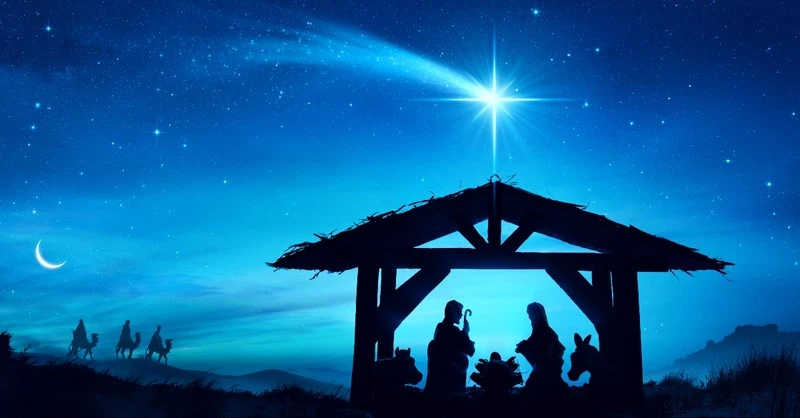
Christmas proclaims the best news ever: God sent his Son. What the Son does is restore heaven’s reign to earth.
Matthew lights up his portrait of the Christ-child from five angles. All of them highlight a single message: heaven’s authority arriving in the Christ-child.
This is the good news, the enduring wonder of Christmas. Watch how Matthew progressively illuminates his portrait of the Christ-child:
- The first is starlight. Centuries before, the light of heaven’s leadership had gone from Israel. Now, representatives of the kingdoms that had conquered them arrived to recognize the Star rising to rule God’s people (Numbers 24:17). Led by heaven, they came to give their allegiance to the Christ-child: Where is the one who has been born king of the Jews? We saw his star when it rose and have come to worship him. (Matthew 2:2)
- The second is a spotlight from heaven (Micah 5:2-4). By divine decree, this seemingly insignificant child was to rise and represent the throne of God on earth as his father David had done: You, Bethlehem, in the land of Judah, are by no means least among the rulers of Judah; for out of you will come a ruler who will shepherd my people Israel. (Matthew 2:6)
- The third glow is the pillar of fire that led Israel out of oppression in Egypt to establish them as God’s firstborn nation (Exodus 4:22). When they fell back under the power of the nations, God promised to restore them as his child (Hosea 11:1). In the Christ-child, God has come to make that journey with them: Out of Egypt I called my son (Matthew 2:15)
- The fourth is a distant light at the end of the tunnel. Jeremiah heard Rachel’s voice grieving across the centuries for her children who had died at the time of the exile (Jeremiah 31:15). The Christ-child is born into the threatened existence of his people: A voice is heard in Ramah, weeping and great mourning, Rachel weeping for her children and refusing to be comforted, because they are no more. (Matthew 2:18) But death will not be the last word (Jeremiah 31:16-17, 31).
- The final light is broad daylight. The Christ-child grows up in plain sight, but not in the capital where all these power machinations take place. He grows up among the God-fearing peasants of the backwater of Galilee, as a Nazarene. (Matthew 2:23)
All five illuminations from the Law and the Prophets form a single portrait. This child has received authority to restore heaven’s reign to the earth. Rulers who do anything to keep their power will attempt to get rid of the prince of heaven, but they will fail. The conflict against divine authority reaches its apex in him, yet he establishes heaven’s reign.
This child is born to liberate the earth from evil and oppression, to restore the earth to heaven’s reign.
So, c’mon! Let’s celebrate Christmas. The war against God is over. The reign of God has begun in Christ.
Is that how you tell the Christmas story?
What others are saying
R. T. France, The Gospel of Matthew, NICNT (Grand Rapids, MI: Eerdmans, 2007), 40:
These 31 verses [Mt 1:18–2:23] are one of Matthew’s most distinctive contributions to the Christian story. Their narrative content is largely unparalleled in the other gospels (see below for the limited area of overlap with Luke), and in any case it is not narrative which is their main focus, but rather a series of quite creative and sophisticated arguments to show how in the coming of Jesus a wide range of scriptural material finds its destined fulfillment. If the “formula-quotations” are one of the most distinctive features of this gospel (see above pp. 11–14), then it is surely significant that five of them (nearly half of the total) occur in these 31 verses alone. Their function here is not merely that of incidental editorial comment; rather these quotations form one of the key structural principles of the whole section. Each of the five scenes into which the narrative divides focuses on one of the formula-quotations, in such a way that it seems that the incident is narrated for the purpose of demonstrating the fulfillment of Scripture. In other words, Matthew’s gospel contains different stories concerning the infancy of Jesus not only or mainly because Matthew had access to different traditions, but rather because he was mounting a carefully constructed argument from Scripture and it is these particular incidents which enable him to present it.
More detail
For more on each of these five illuminations, see:
- King of the Jews (Mt 2:1-10)
- How did the magi find Jesus? (Mt 2:1-12)
- Jesus fulfils what? (Mt 2:13-15)
- God as asylum seeker (Mt 2:16)
- An unknown from nowhere (Mt 2:17-23)
And for background from Matthew 1:
Merry Christmas as we celebrate the restoration of heaven’s reign in him.
Seeking to understand Jesus in the terms he chose to describe himself: son of man (his identity), and kingdom of God (his mission). Riverview Church, Perth, Western Australia
View all posts by Allen Browne
Post navigation
Republished with permission from Blogs.crossmap.com, featuring inspiring Bible verses about Five inspirational angles on Christmas (Matthew 2).